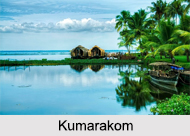 Kumarakom is a popular Backwater tourism destination of Kerala which is a part of the Kuttanad region. It is situated on the banks of the Vembanad Lake, one the world famous Backwater destinations of Kerala. Fishing, Boating and visit to the countryside make this destination a unique place to look forward to. Kumarakom also has a small bird sanctuary where different species of birds can be seen.
Kumarakom is a popular Backwater tourism destination of Kerala which is a part of the Kuttanad region. It is situated on the banks of the Vembanad Lake, one the world famous Backwater destinations of Kerala. Fishing, Boating and visit to the countryside make this destination a unique place to look forward to. Kumarakom also has a small bird sanctuary where different species of birds can be seen.
History of Kumarakom
Kumarakom was under the authority of the king of Thekkumkur and the fighting and competitions were common among the local kings. Small boats called "chundan vallam" and "veppu vallam" were broadly used among the local kings for their lightning attacks and fighting in central Travancore. During those days Vembanad Lake was an unsafe area and therefore king of Thekkumcore kept his soldiers in Kumarakom and constructed a fort at the entrance of Kottathodu in Kumarakom. Soldiers were kept in certain areas of Kumarakom for the safeguard against enemy attacks. The remains of the fort`s wall, six feet broad, can still be seen near the village office of Kumarakom.
 Climate of Kumarakom
Climate of Kumarakom
Kumarakom has a temperate climate all through the year. It is a balanced tropical climate, which has two monsoons south west and north east. The average rainfall is 1100 mm. It is a home to a large variety of flora and fauna.
Culture of Kumarakom
Main religions of Kumarakom are Hinduism, Islam and Christianity. Fishing, agriculture and tourism are the main economic activities. Fishing is mostly done using the small boats (vallams) and gill nets (gear). The main catches are black clam (Villorita cyprinoides), Karimeen (Pearl spot) and shrimp (Metapenaeus dobsonii). Kumarakom has a wide variety of houseboats and is well known throughout the world for houseboat experience. They are used only for tourists these days. The rich agricultural environment is primarily irrigated using combined waterways and canals of the Meenachil River.
Attraction of Kumarakom
Kumarakom offers visitors many more leisure options. Here are some of the attractions of Kumarakom:
Aruvikkuzhi Waterfalls: This beautiful Waterfall make their way through a beautiful landscape and waters roar as they fall down from the mountains of a height of 100 feet.
Erumely: This is an important pilgrimage centre for the Hindus and Muslims. Sree Dharmasastha Temple here is an ancient temple dedicated to Lord Ayyappa.
 Aranmula: It is the site of the splendid Onam festival boat races, usually held in early September. These races unlike the more sporting Nehru Trophy race at Alappuzha in August are essentially religious, based on a temple festival. Caparisoned elephants with beaded umbrellas, processions of decorated floats, and highly ornate boats make this a lovely event to witness. Aranmula is also the centre of bell metal mirror crafts.
Aranmula: It is the site of the splendid Onam festival boat races, usually held in early September. These races unlike the more sporting Nehru Trophy race at Alappuzha in August are essentially religious, based on a temple festival. Caparisoned elephants with beaded umbrellas, processions of decorated floats, and highly ornate boats make this a lovely event to witness. Aranmula is also the centre of bell metal mirror crafts.
Vagamon: Situated at an elevation of 1100 meters above sea level is a trekker`s paradise. It is an ideal tourist spot surrounded by the greenery of tea gardens, beautiful meadows and valleys.
Elaveezha Poonchira: Elaveezha Poonchira is yet another picnic spot accessible from Pala and located in the midst of beautiful hills.
Vaikom: It is famous for the Shiva Temple. The festival in November-December, last for 12 days and the `Panchavadyam` is an important musical performance.
Visiting Information of Kumarakom
The nearest airport is at Kochi, which is 80 kilometres away and the nearest railway head is Kottayam which is 16 kilometres away, which is well connected by trains from all major cities in India. It is easily accessible by road also.



















